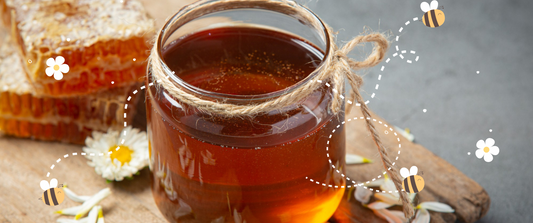Imagine a bustling beehive – a world of order and teamwork. Beekeepers who understand the rhythms of this mini society know that there's more to honey harvesting than meets the eye. In this article, we'll uncover the why and how of harvesting honey from the super chamber, a practice that aligns with nature's plan and makes for better honey on our tables.
The Two Chambers: A Closer Look
Inside a beehive, there are two distinct chambers: the super chamber and the brood chamber. These chambers each have their roles and importance in the intricate lives of bees.

The Brood Chamber: The Hive's Nursery
The brood chamber is like the bustling heart of the hive. This is where the queen bee lays her eggs, and where baby bees are born and nurtured. The bees here work round the clock to care for the developing larvae, creating a warm and cozy environment to help them grow. This chamber is essential for the hive's survival and growth.
The Super Chamber: The Surplus Honey Storage
Above the brood chamber is the super chamber, often referred to as the honey super. This is where the bees store excess honey. As nectar comes in from foraging, the bees deposit it in the brood chamber first. Once the brood chamber is well-stocked, the extra nectar goes up to the super chamber. Here, worker bees fan the nectar with their wings, reducing its moisture content. When the honey reaches the right moisture level, bees seal the cells with wax – a sign that the honey is ready to be enjoyed.
The Unfortunate Shortcut: Harvesting from the Brood Chamber
Most of the honey harvested in the country is collected from the brood chamber where it remains uncapped. In fact, a significant number of beekeepers do not even use a super chamber. Being uncapped, honey from the brood chamber naturally contains a high moisture content. As bees initially deposit nectar in the brood chamber before storing surplus in the super chamber of the hive, the practice of extracting uncapped and unripened honey from the brood chamber has become a shortcut for honey harvesters. This practice is not only unethical towards bee colonies but also cruel, as it results in the destruction of immature larvae and eggs during the extraction process.
Due to the high-moisture content of the near-watery honey extracted from the brood chamber, it requires pasteurization to thicken and reduce the moisture level. And due to pasteurization, all the natural properties of honey get destroyed.
This creates a vicious cycle of unscientific beekeeping.
Harvesting from the Super Chamber: The Why and How
When beekeepers harvest honey exclusively from the super chamber, they're honoring the bees' natural order. The capped cells indicate that the honey is ripe, with lower moisture content and better quality. By taking honey from the super chamber, we're ensuring that the bees' hard work in the brood chamber – nurturing new generations – remains undisturbed.
Harvesting honey from the super chamber isn't just a beekeeper's preference; it's a nod to the dance of nature. The brood chamber is the hive's nursery, while the super chamber is the honey storage. Each has its unique role, and by working in harmony with this natural arrangement, we not only get the best honey but also support the bees' delicate balance.
The next time you enjoy a spoonful of honey, remember that its journey from the super chamber to your table is a testament to the beautiful collaboration between humans and the honey-making heroes of the hive.







1 comment
I enjoyed this article.